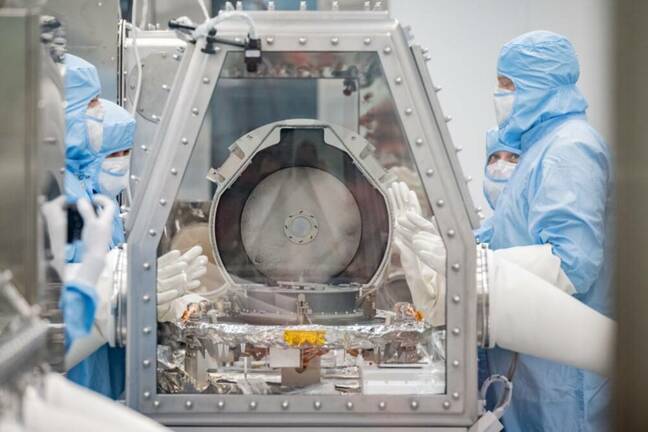NASA taking its time unboxing asteroid sample because it grabbed too much stuff
Dirty deed, done in deep space
NASA is running late in its efforts to share 4.5-billion-year-old dust samples with researchers, blaming the delay on its OSIRIS-REx spacecraft returning more material than expected.
Launched in 2016, the probe was the space agency's first-ever mission to fetch ancient rocks from an asteroid. OSIRIS-REx came equipped with a robotic arm to pick up regolith from the surface of Bennu, stowing it away in its TAGSAM (Touch-and-Go Sample Acquisition Mechanism) head.
The probe performed its sample collection maneuver in 2020. Mission control already knew back then that it was carrying much more than the 60 grams of dust and rock NASA hoped to collect, after the TAGSAM leaked material. The probe successfully returned the sample to Earth, and landed in a desert in Utah last month.
Now, officials are proceding slowly to ensure they doesn't lose any of the precious matter. But dust on the outside of the capsule is complicating their task.
"The very best 'problem' to have is that there is so much material, it's taking longer than we expected to collect it," explained deputy OSIRIS-REx curation lead Christopher Snead, in a statement. "There's a lot of abundant material outside the TAGSAM head that's interesting in its own right. It's really spectacular to have all that material there."
All this means that scientists hoping to get their hands on the billion-year-old dust samples will have to wait longer than expected, as NASA works to extract and analyze the material. Researchers will take a closer look at the dark particles that are sticking to the inside of the TAGSAM's canister lid and base first, while the bulk of the sample is stored safely inside the canister.
- OSIRIS-REx successfully delivers NASA's first asteroid sample
- NASA's first asteroid sample on its way to Earth after OSIRIS-REx boosts for home
- NASA trying to stuff excess baggage into OSIRIS-REx after too-successful asteroid scoop
- No need for more asteroid-blasting attempts, NASA's OSIRIS-REx has more than enough space dirt
"We have all the microanalytical techniques that we can throw at this to really, really tear it apart, almost down to the atomic scale," said Lindsay Keller, a member of the OSIRIS-REx sample analysis team. The results will give scientists a sneak preview of what they should expect when NASA finally cracks open the canister and sends samples off to labs around the world.
NASA wants to investigate Bennu's chemical composition and study whether it contains hydrated minerals or organic compounds, and estimate its capacity to absorb and release heat. The samples will be probed with a scanning electron microscope, infrared measurements, and x-ray diffraction.
After getting every last scrap of the dust inside the TAGSAM head, the device will be moved into a specialized container for scientists to open the canister, preventing any contamination of the sample stored within.
Bennu appears to be a loosely affiliated pile of rocks that likely formed from a larger asteroid that broke apart. Scientists believe that objects like Bennu may have delivered water and organic molecules onto Earth, and eventually made it possible for you to read this very story. ®

 Biting the hand that feeds IT
Biting the hand that feeds IT